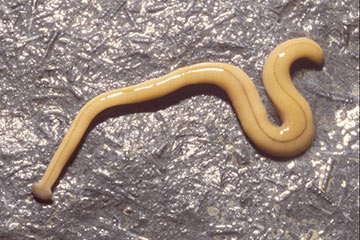Bulletin News

08/12/2023
Flatworms, also known as planarians, prefer a quiet, dark spot. So you don’t expect to find them baking in the glare of the media spotlight aimed by news outlets like CNN and NBC.
That recent focus is on the truly weird variety of planarians known as hammerhead worms or broadhead planarians. The headlines have stressed the odd-looking worm’s toxic secretions, carnivorous hunting habits and the fact it is an invasive species from Southeast Asia.
But, thanks to the expertise SUNY Cortland’s Peter Ducey and his students, the body of the stories include reliable facts that show they aren’t the cause for alarm they’re sometimes portrayed as.
“Sometimes people are interested in invasive worms because it’s a sky is falling, ‘These invasives are going to eat up everything’ kind of thing,” Ducey said. “And this is not really one of those cases in general.”
Ducey, a distinguished teaching professor in the university’s Biological Sciences Department, specializes in flatworms, reptiles and amphibians. He’s been involved with several research studies on the hammerhead that are cited on websites like the National Invasive Species Information Center and Wikipedia.

The recent fascination was sparked by increased sightings of the planarians, which resemble flattened slugs with a front end shaped like an arrowhead, in areas across the country.
It’s not the first time there’s been a sudden media focus on these species. Ducey has contributed to local news stories about planarians in the past, but this is the first time the topic has reached such a large national audience.
“This sort of thing has been occurring off and on over the last couple of decades,” Ducey said. “Every once in a while, someone will find one in their yard someplace and raise the alarm. There will be a couple of stories and then it dies away. But a month ago, it seemed like there was a mushrooming of those stories across the country.”
Despite the recent alarm about an invading species that eats earthworms, a lack of past studies makes it hard to know whether flatworms are spreading rapidly or have had similar numbers in the northern area for decades. Most people never actively looked for flatworms until social media made their existence a more widely known issue.
If a flatworm is spotted, he cautions against touching it with bare skin. Planarians have a neurotoxin, tetrodotoxin, that can be hazardous. This toxin, the same found in most pufferfish and some salamanders, can’t enter the body through skin. However, exposure on a cut or by touching your eyes or mouth is possible. Ducey and his students all wear gloves when handling them.
There are five species of broadhead planarians reported to be in the United States, according to Ducey. Three are in the southern parts of the country and two are northern. One species in the South and one in the North have been widespread across the country for decades. Two of the southern species are now increasing their ranges.
That doesn’t mean there’s cause to be a flatworm fatalist.
“It’s not, all of a sudden, puff — here they are,” Ducey said. “Several species have been in North America for probably 100 years.”
The most likely place to find these planarians are moist, shady areas like gardens, forests and under rocks. While they aren’t going to wreak ecological havoc in your yard, he does agree that any changes brought on by the planarians need to be monitored.
“They are relatively new things to the ecosystems of North America, and they are very effective predators, so they could have negative effects on ecosystems here. Several of the species feed on earthworms, and earthworms do play significant roles within soil ecosystems. But many of the earthworms in North America are themselves not native to the continent. It makes the story a little more complicated. If the flatworms were coming in and eating native species, that would make them the bad guys. But now they’re coming in and eating both invasive earthworms and native earthworms. They might be having some minor positive effects by eating the invasive worms.”
Climate change, while a possible contributor to the spread of the southern flatworms, is probably not a major factor, according to Ducey. Instead, it’s a lack of natural predators making it easy for hammerhead worms to thrive. In fact, the flatworms’ ability to stay on top of their own food chain is one of the things he finds most fascinating about them.
“Even though they’re small, soft, squishy worms, they are amazing predators,” Ducey said. “They take on prey items 10-, 15- and 20-times their own mass. It’s sort of like a house cat attacking a white-tailed deer.”
The planarians also have an extraordinary ability to regenerate that puts them far beyond other worms. Ducey notes that some of the flatworm species can be cut into 10 pieces, with all those pieces growing back the parts required to become complete, functioning worms. It’s a trait being studied by scientists with the hope of developing similar regenerative abilities in human medicine.
Ducey says his own decades-long research at Cortland has been helped by the university’s undergraduate research program. He estimates that dozens of students have helped his research through this program, with many of them subsequently listed as published authors alongside Ducey in peer-reviewed scientific journals.
“They go on to become everything, but the experience they have in science can help them,” Ducey said. “Some of them got Ph.D.s and are now professional scientists, but many of them are high school teachers, doctors, dentists, physician assistants or nurse practitioners. The students that work with these worms or with the reptiles and amphibians have all those kinds of careers now.”

